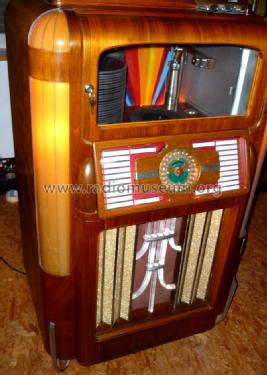Jukebox 24-A
Wurlitzer Co., The Rudolph; North Tonawanda, NY
- Country
- United States of America (USA)
- Manufacturer / Brand
- Wurlitzer Co., The Rudolph; North Tonawanda, NY
- Year
- 1938/1939
- Category
- Sound/Video Recorder and/or Player
- Radiomuseum.org ID
- 204617
Click on the schematic thumbnail to request the schematic as a free document.
- Number of Tubes
- 5
- Main principle
- Audio-Amplification
- Wave bands
- - without
- Details
- Jukebox-Coin operated Phonograph
- Power type and voltage
- Alternating Current supply (AC) / 110 Volt
- Loudspeaker
- Electro Magnetic Dynamic LS (moving-coil with field excitation coil)
- Material
- Various materials
- from Radiomuseum.org
- Model: Jukebox 24-A - Wurlitzer Co., The Rudolph;
- Shape
- Console with any shape - in general
- Dimensions (WHD)
- 31 x 52 x 25 inch / 787 x 1321 x 635 mm
- Notes
- The Wurlitzer model 24-A is a Paul Fuller design, introduced 1938 but also sold in 1939 unlike model 24 which was discontinued already in 1938. With this model for 24 selections (on one side of 24 records for 78 RPM) Wurlitzer shocked the industry which offered still 12 selections. The Wurlitzer model 24 was also the first jukebox to incorporate illuminated plastics into its design. The evolution from heavy wooden cabinets to a bright and then modern deco style including colored lights and plastics helped to establish Wurlitzer’s pre-eminenence in the coin-operated phonograph industry.
The model 24-A is a Model 24, equipped with magnetic coin selectors, butterfly switches, Wurlitzer coin entry slides and a built-in scavenger cup. The only visible, external difference between a Model 24 and 24-A is that the 24-A has a coin return cup on the lower right front corner. The 24 has a simple coin system that does not reject phony coins and was used in "good" locations. The 24-A had a sophisticated coin system that could reject phony coins and was used in "bad" locations where customers may try to fool the machine with fake coins. The phony coins were expelled into the coin return cup on the 24-A.The model 24 and 24-A use the model 851 amplifier (also model 600 and others use it).
The lower plastic rods are Lucite, which can bend the different colors of light shined into them from above. The plastics are very thin and brittle and almost always are broken today. These jukeboxes are rather rare.
- Author
- Model page created by Ernst Erb. See "Data change" for further contributors.
- Other Models
-
Here you find 235 models, 147 with images and 83 with schematics for wireless sets etc. In French: TSF for Télégraphie sans fil.
All listed radios etc. from Wurlitzer Co., The Rudolph; North Tonawanda, NY
Collections
The model Jukebox 24-A is part of the collections of the following members.




